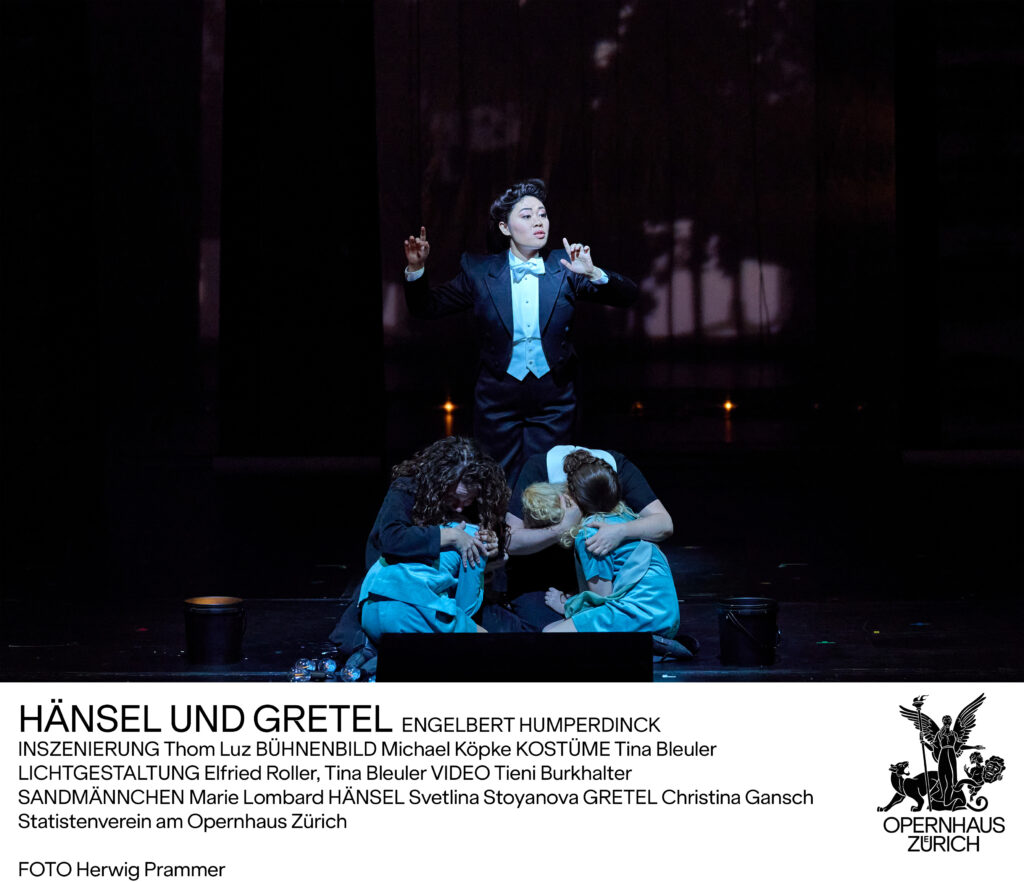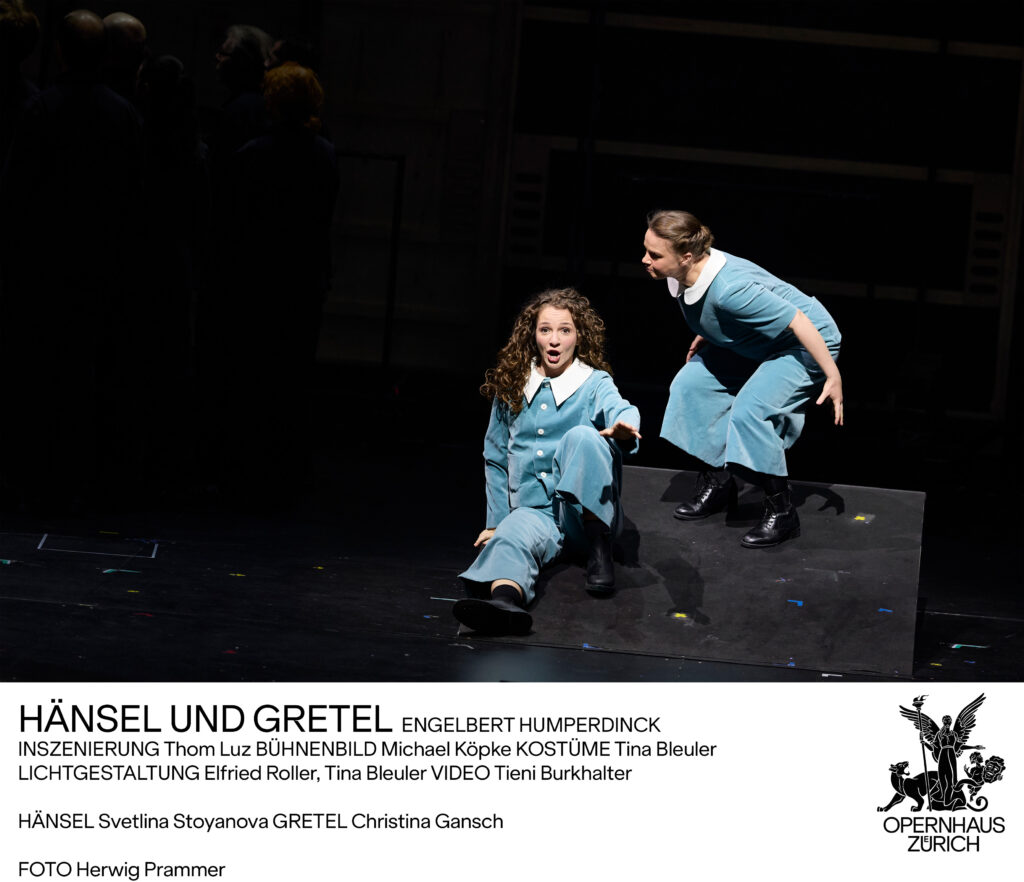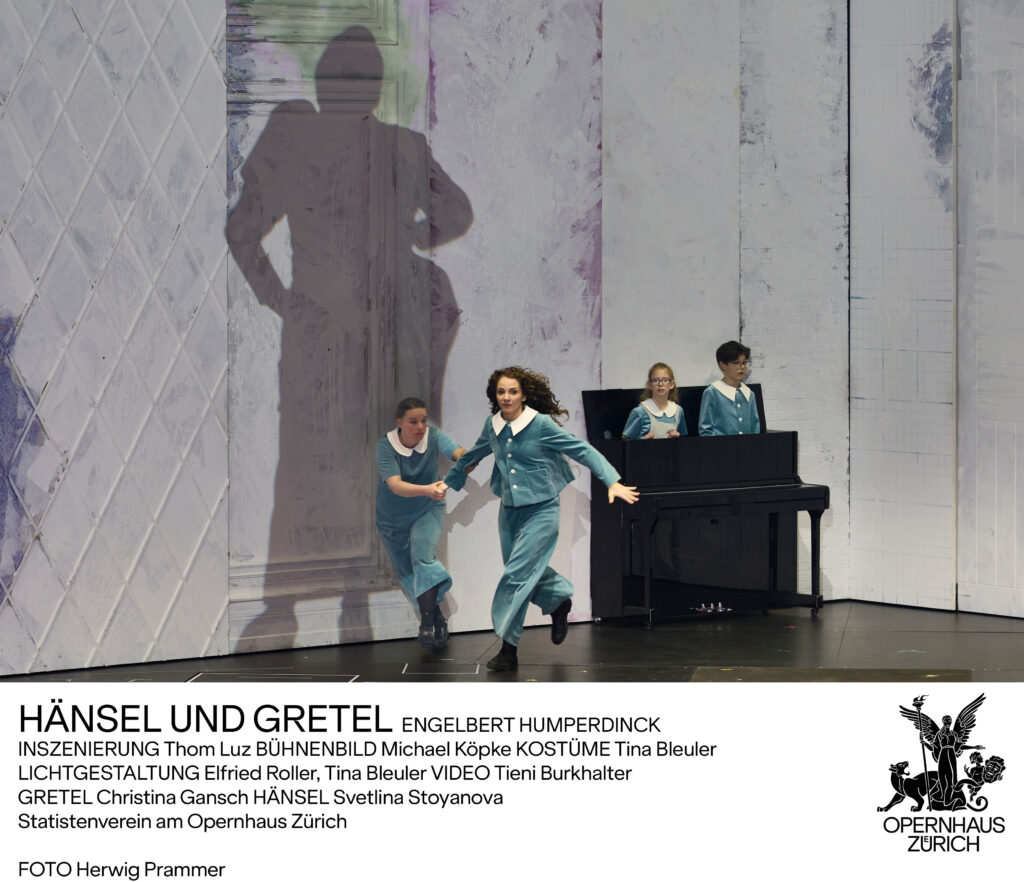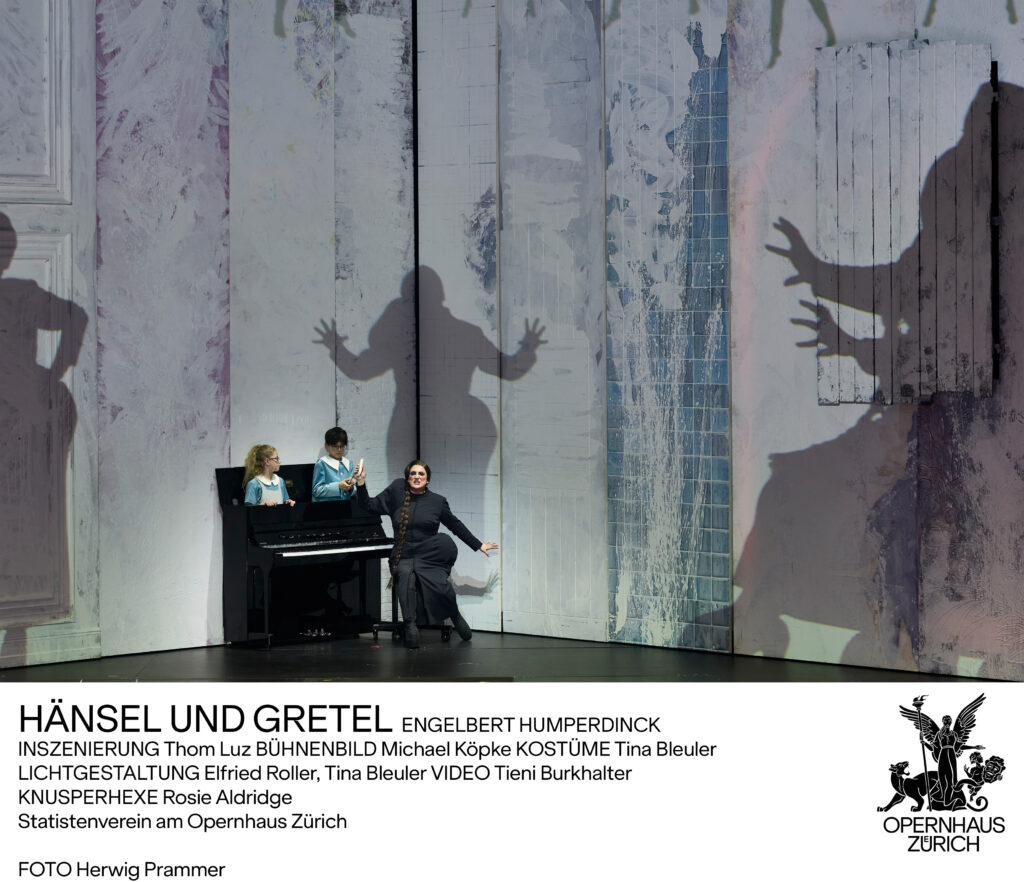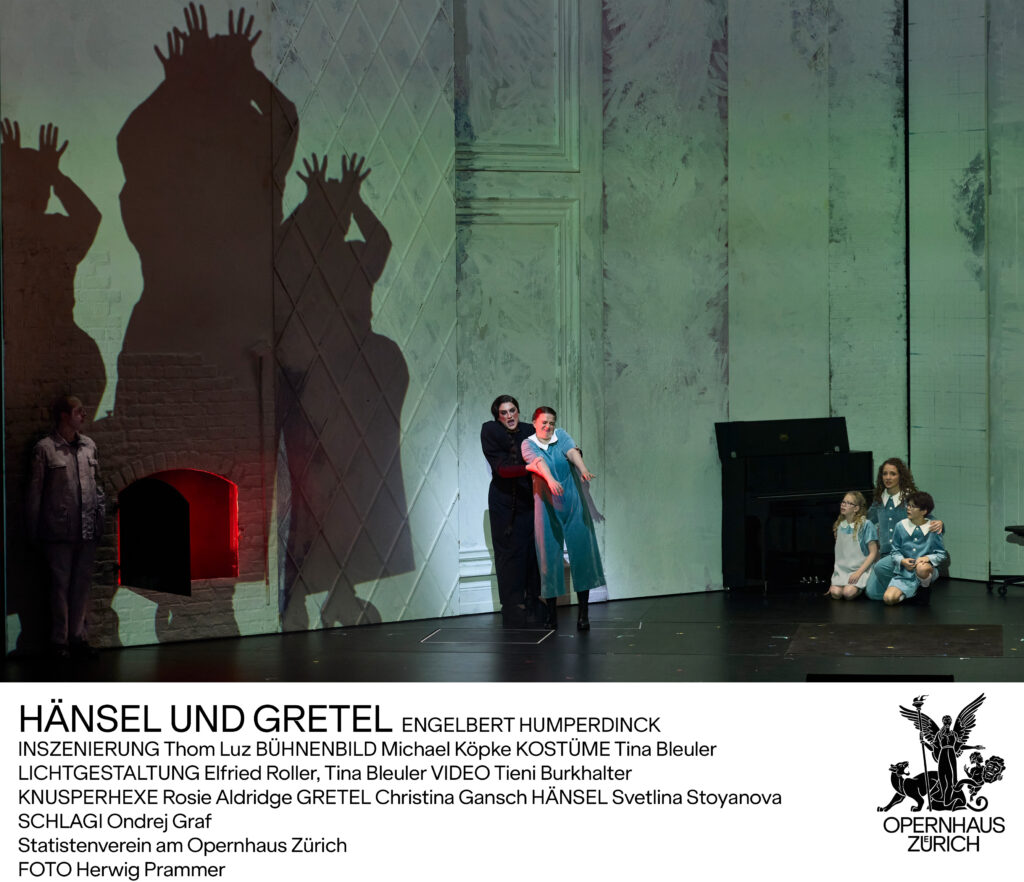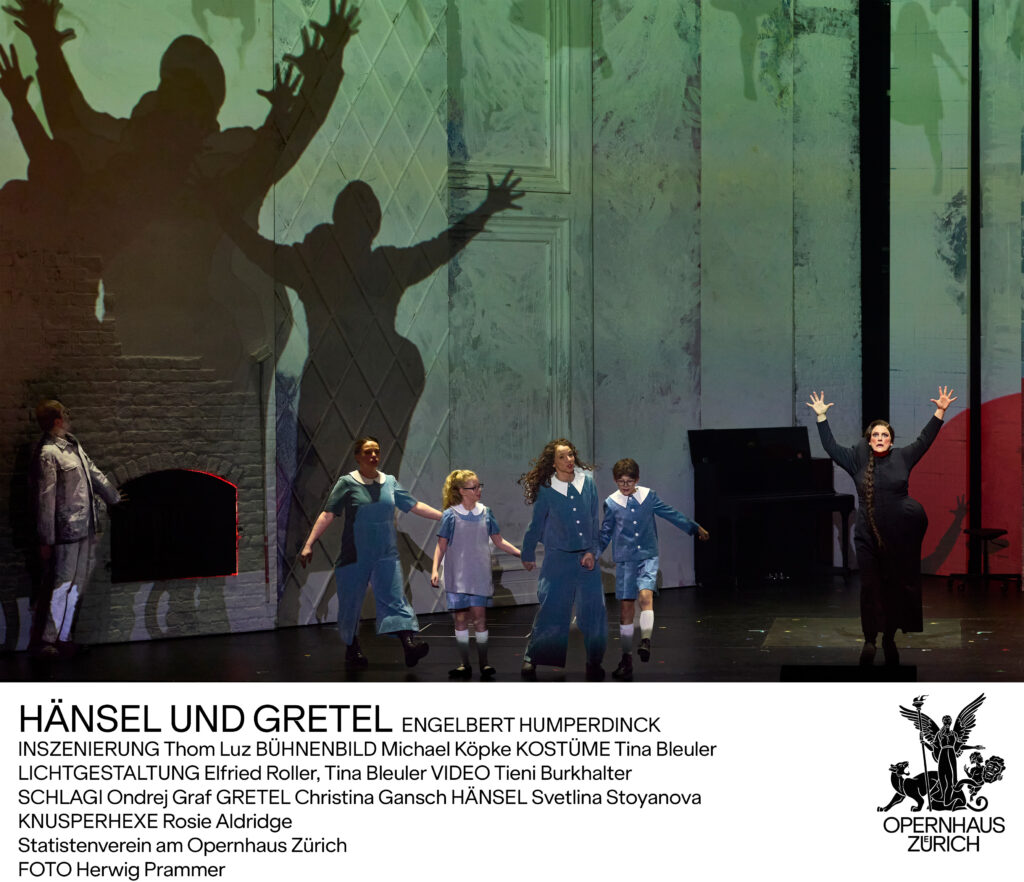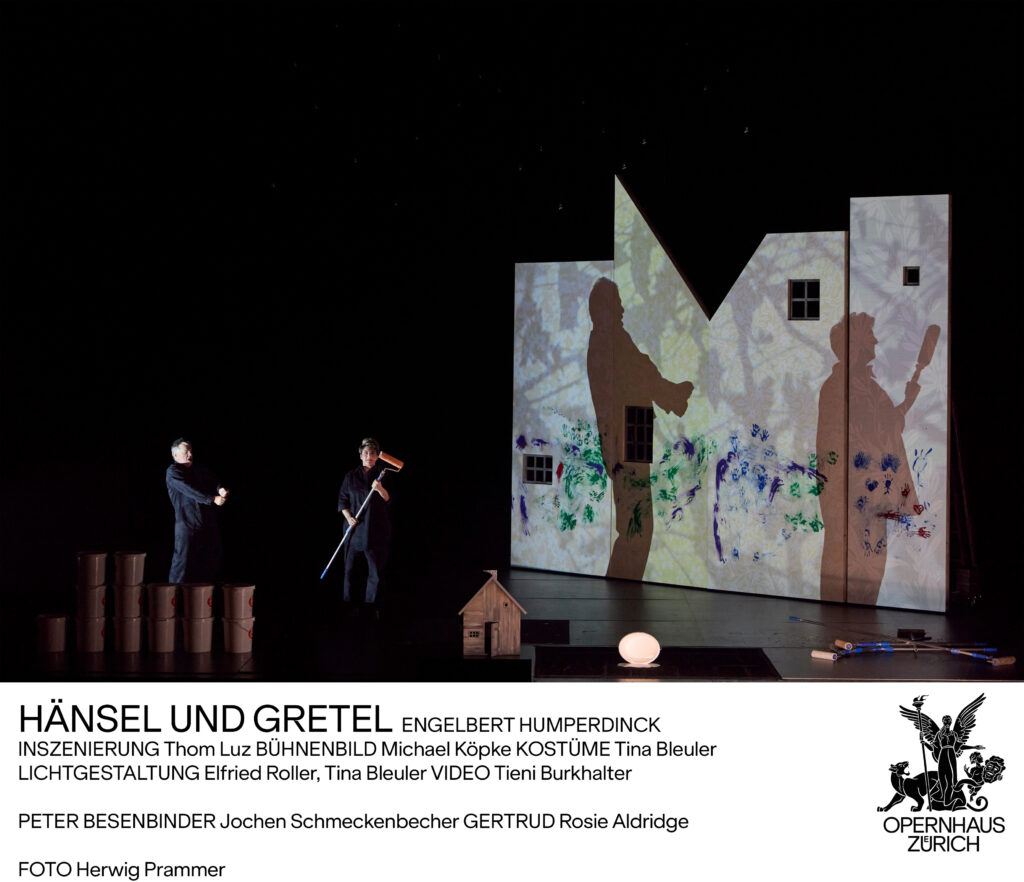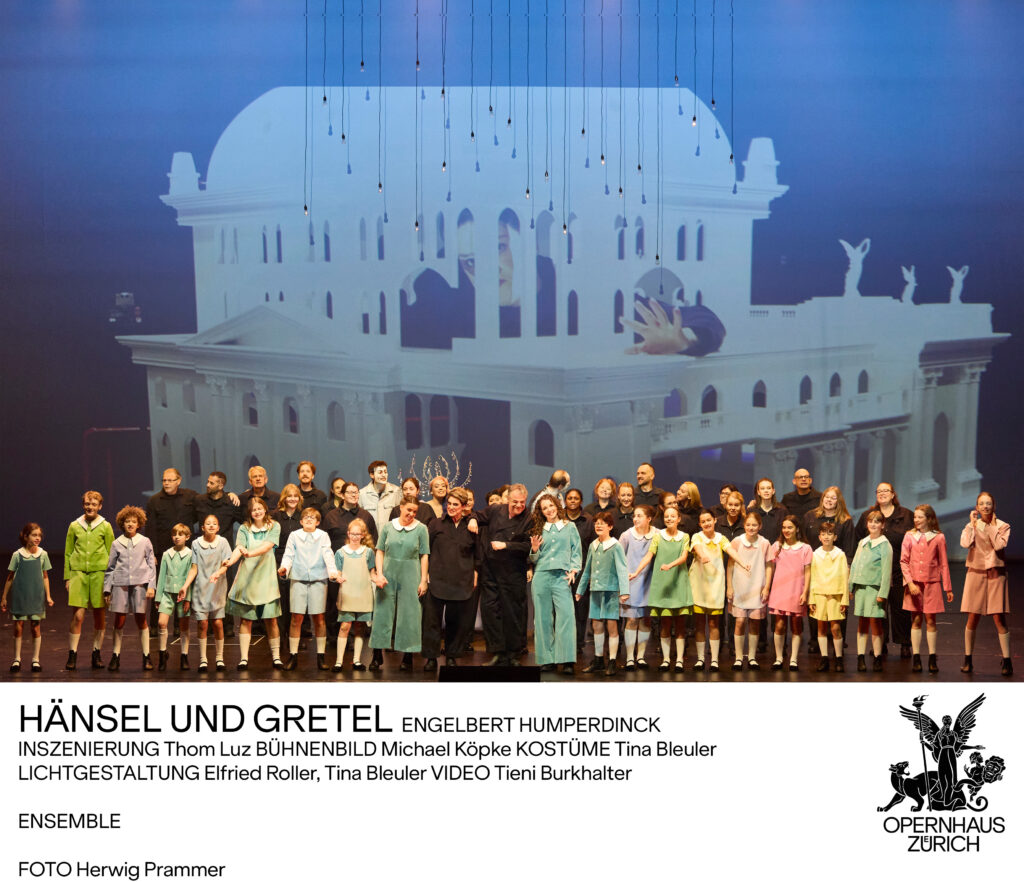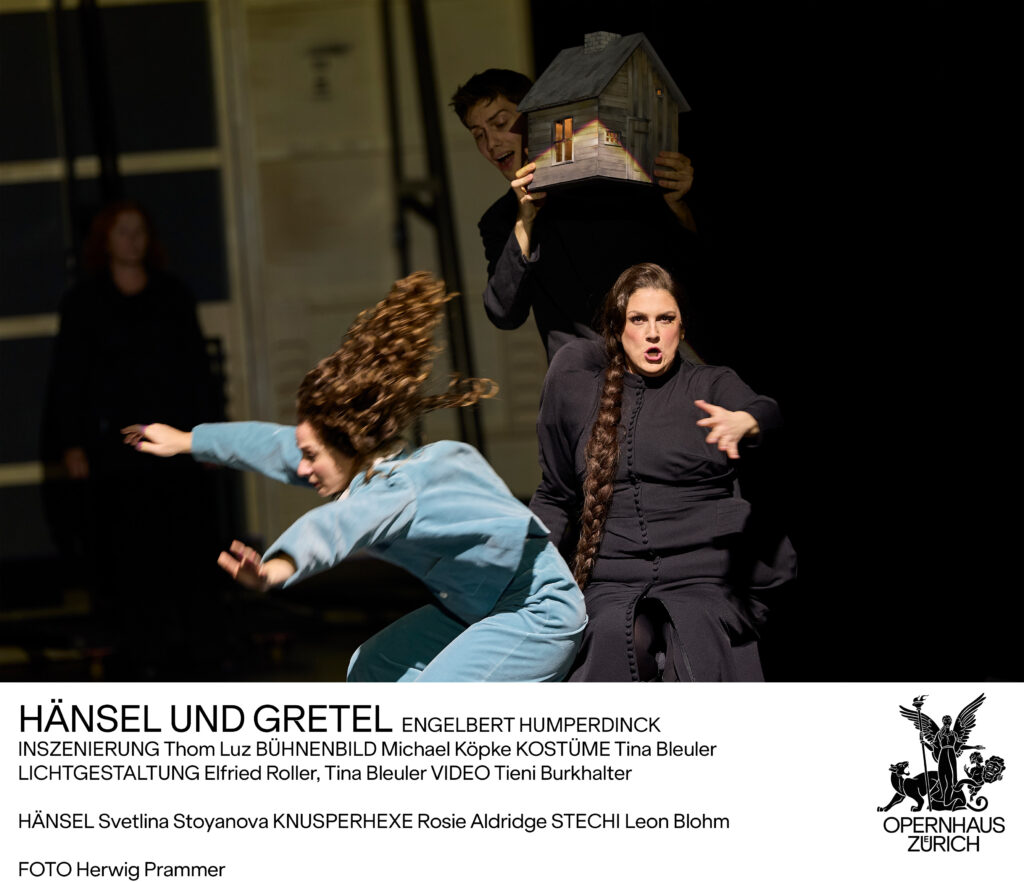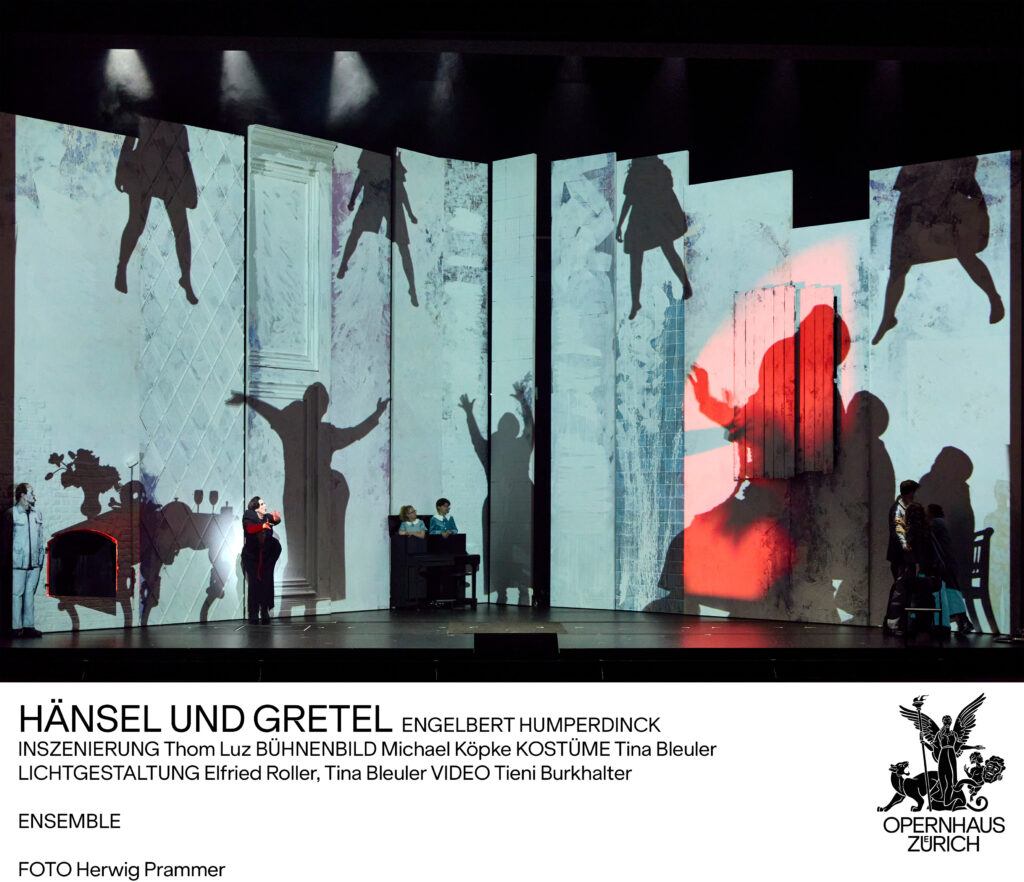Fairy-tale play in three scenes. Music by Engelbert Humperdinck (1854-1921). Libretto by Adelheid Wette after the fairy tale by Jacob and Wilhelm Grimm.World premiere: 23 December 1893, Weimarer
Hänsel und Gretel
Performance of 16 November 2025 at 17:00 (Premiere)
The premiere performance was recorded and broadcast live to cinemas in the Canton of Zurich as part of Opera Cinema Day.
Musical direction: Giedrė Šlekytė
Production: Thom Luz
Set design: Michael Köpke
Costumes: Tina Bleuler
Chorus master: Klaas-Jan de Groot
Lighting design: Elfried Roller, Tina Bleuler
Video: Tieni Burkhalter
Dramaturgy: Roman Reeger
Peter, the broom-maker: Jochen Schmeckenbecher
Gertrud / Gingerbread Witch: Rosie Aldridge
Hänsel: Svetlina Stoyanova
Gretel: Christina Gansch
Sandman: Marie Lombard
Dew Fairy: Sylwia Salamońska-Bączyk
Light Piano: Anna Hauner
Stechi: Leon Blohm
Schlagi: Ondrej Graf
Orchestra of Zurich Opera
SoprAlti and children’s chorus of Zurich Opera
Supernumeraries of the Zurich Opera House
Musik: 4****
Regie: 5*****
Hänsel und Gretel
From a musical point of view (musical direction: Giedrė Šlekytė, Orchestra of Zurich Opera), the evening began with a certain sense of unease. After the very first bar of the overture the wind players showed a slight lack of precision; the transitions did not sound entirely clean, and the orchestra seemed at first to need to find its footing. In terms of musical shaping – dynamics, tempo changes, agogics – the overture did not quite reach its potential; it might well have been more impish, more daring, more colourful. At times the sound recalled Dvořák rather than the opulent Straussian palette we might have hoped for.
Improvement
Fortunately, improvement was not long in coming. With the first appearance of the singers, a musical pulse seemed to flow from the stage back to the conductor and orchestra. The music-making became freer, gained momentum, and it was striking to observe how impulses from the stage radiated back into the pit. This shift was particularly evident in the scenes with Rosie Aldridge, who appeared both as Gertrud and – magnificently – as the Witch. Her portrayal of the Witch was delivered with an infectious mix of vocal excellence, dramatic force and sharply pointed facial expression. Together with the orchestra, an almost alchemical effect emerged, providing the evening with precisely the sparks that had felt missing at the start.
That Hänsel und Gretel is classed as a children’s opera is a truism. Yet the sight of what felt like half the audience being under ten years old was still surprising – and initially raised the fear that things might become lively and restless in the auditorium. The opposite occurred: with admirable concentration, the young audience followed the action. Even in the most delicate pianissimo passages there was a stillness and attentiveness that many a “grown-up” performance would envy. A rare, awe-inspiring and moving experience – one that challenges the widespread notion that children need simplified, slapstick-laden or overly didactic opera versions in order to stay engaged. This production demonstrated impressively that high-quality art needs no pandering to captivate even the youngest spectators.
Impressive
We found the production by the Zurich-born director Thom Luz extraordinarily impressive. Luz, who first encountered the magic of opera as a child at Zurich Opera House and later studied music and theatre at the Zurich University of the Arts, continued his artistic journey through numerous city and state theatres as well as opera houses – including the Deutsches Theater Berlin, the Staatsoper Unter den Linden, the Schauspielhaus Hamburg, the Salzburg Festival, the Wiener Festwochen, Theatre Basel and the Munich Residenztheater. With his own production at Zurich Opera House, a remarkable artistic circle is completed.
It is almost impossible to find adjectives that adequately describe his style: poetic, magical, ethereal, imaginative, visually powerful and surprisingly original – and at the same time imbued with a quiet, life-affirming humanity. One had the impression of having witnessed something genuinely new – something that diverged refreshingly from the familiar patterns of contemporary director’s theatre. A welcome and invigorating experience.
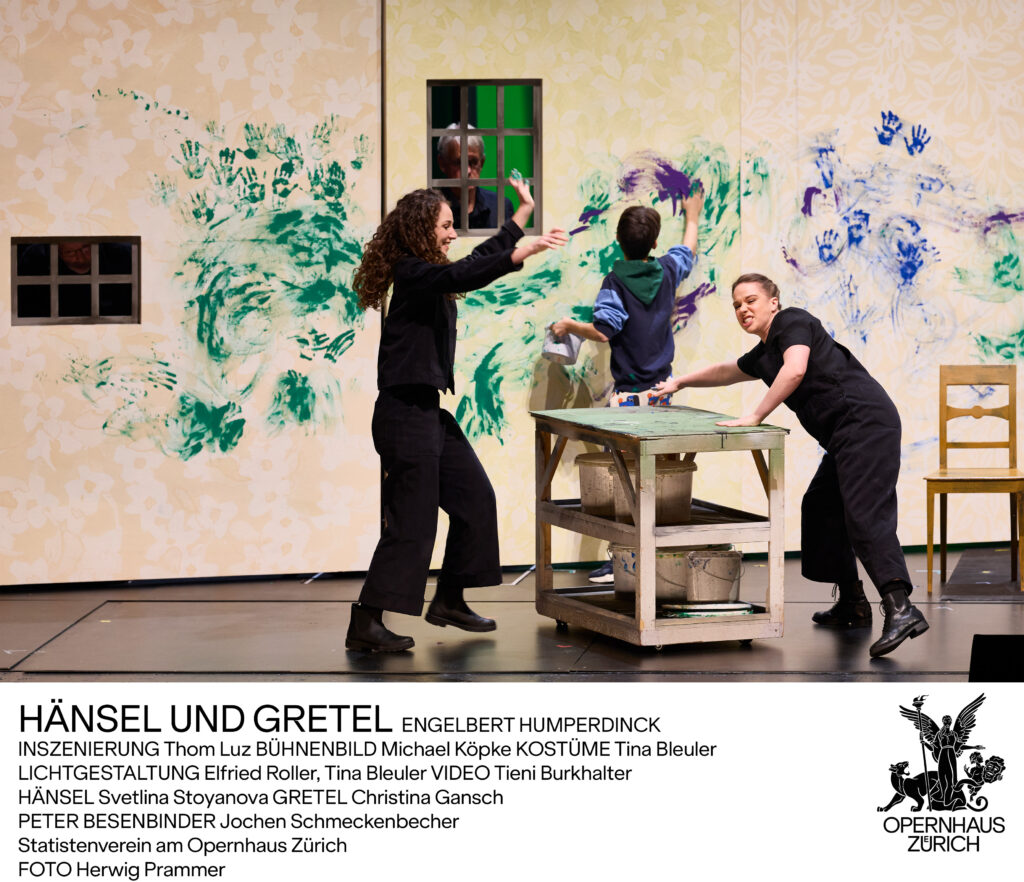
At the very beginning, the large stage (set design: Michael Köpke) at Zurich Opera House opened out in an unusually expansive way; for the first time one could see right into the furthest corners, and it became apparent that the space behind the stage is many times larger than the actual playing area. At the very back appeared a pianist (Light Piano: Anna Hauner), who seemed almost kilometres away. She stepped forward and sat down at a piano whose glowing cables ran up into the fly tower; her playing created a delicate play of light – a touching, warmly radiant effect, wonderfully synchronised with the music.
Throughout the performance, Luz continuously surprised with visual inventions closely interwoven with the musical structure. Light and shadow (lighting design: Elfried Roller, Tina Bleuler; video: Tieni Burkhalter) were used in multiple ways and took on their own dramaturgical function. The projected silhouettes developed lives of their own – for example when the Witch’s shadow suddenly displayed several arms, almost in the manner of Kali: a strikingly original detail.
The forest emerged right before the audience’s eyes: strips of fabric, first painted on stage, were hoisted upwards and, with the dimming of the lights, transformed into trees. Artificial smoke was used several times; one could even see it being produced on stage. The deliberately visible stage machinery had a charm all of its own.
Comic was the sudden appearance of Peter, the broom-maker, rising from beneath the stage; delightful, too, was the soft rustling shadow-play of the leaves, perfectly timed to the music. Impressive as well was the release of the enchanted children, who were lowered from the ceiling with the help of the stage crew. Also interesting was the decision to have Hänsel and Gretel portrayed simultaneously by two children, while the singers representing them followed behind – an appealing double perspective on the characters.
This production displayed a visual originality rarely encountered: aesthetic, artful, innovative. It was refreshing to experience a staging that does not strain after socio-political interpretations but instead focuses entirely on a total work of art uniting music, stage and direction. For the magical, ethereal Hänsel und Gretel, Luz’s artistic signature proved ideal.
At the same time, one wondered whether some scenes might have been a little too abstract for children. Luz evidently wished not only to show the magic, but also the mechanics that produce it: the people carrying smoke machines; the technicians fastening children to safety harnesses. A deliberate blending of illusion and reality – perhaps also a message to the young spectators that theatre is a world full of professions, craftsmanship and real work.
Some decisions were less compelling: the splendidly designed oven with its impressive door remained unused; the Witch neither disappeared into it nor was a door dramatically slammed. Instead, Luz had her stand before a red light surface projected onto the back wall. A child asked afterwards explained this pragmatically: “The oven door was probably too small – because of the bump in the Witch’s costume.” Apparently this substitute was entirely adequate and easily understood.
Walkie-talkie
Less convincing were two props – a walkie-talkie that appeared sometimes in Hänsel’s hands, sometimes with the mother, and the scene in which the Witch lit a cigarette. Both elements felt too literal in an otherwise poetic world and disrupted the atmosphere. The meaning of the beautifully crafted model of Zurich Opera House on stage also remained unclear – as did the video sequence after the Witch’s burning, showing her trapped inside this model. Visually intriguing, certainly, but dramaturgically opaque.
The “light piano”, on the other hand, was one of the loveliest ideas of the evening: music transforming into light.
The costumes (costumes: Tina Bleuler) were another of the production’s great strengths. Impossible to place in a specific historical period, they combined fairy-tale elements and fantasy with a subtle touch of humour. Particularly striking was the Witch’s costume: elegant yet grotesquely exaggerated, with pronounced protrusions at shoulder and hip and wittily shaped shoes. The Dew Fairy’s costume also possessed special charm – reminiscent a little of Glinda from The Wizard of Oz or of Alcina, with a large, glittering tulle skirt and an oversized Swarovski tiara.
The ensemble worked wonderfully together; the direction of the performers (dramaturgy: Roman Reeger) felt thoughtful and well balanced. A good mixture of movement and focus ensured that the children in the audience remained curious throughout – making the evening exceptionally entertaining.

Mezzo-soprano Svetlina Stoyanova, singing the role of Hänsel, sang with a warm, resonant timbre that blended beautifully with the soprano of Christina Gansch as Gretel. Gansch impressed with a lovely middle register, great vocal flexibility, and precise coloratura and trills in the Ti-re-li-re-li passage, which she crowned with a particularly successful final note. The subsequent duet, “Mir ist so wohl, ich weiss nicht wie” (“I feel so well, I don’t know why”), was glorious: the two voices intertwined with striking homogeneity, graceful arcs, and an almost ethereal lightness – a moment that made clear just how sensitively and musically the two singers phrased and responded to one another.
Dramatic engine
Rosie Aldridge was the dramatic engine of the evening in both her roles as Gertrud and the Witch: full of energy, precisely crafted, and vocally powerful. Her Witch – with incisively placed top notes and marked dramatic attack – at times recalled the great tragic heroines such as Medea, Elektra or Lady Macbeth. All the more surprising, then, that according to her biography she is not a dramatic soprano but classified as a lyric-dramatic mezzo. At the same time, her interpretation demonstrated compellingly that the Witch should indeed be sung by a female voice – and showed clearly how much dramatic impact and musical truth is lost when the role is cast with a buffo tenor, a choice Humperdinck himself did not favour.
Jochen Schmeckenbecher portrayed Peter, the broom-maker, as a likeable, good-natured father and caused amusement from the moment of his unexpected entrance from under the stage floor.
Even the smaller roles were cast with care and contributed meaningfully to the overall effect of the evening. Marie Lombard offered a Sandman of delicate presence and subtle humour. The quiet moments she introduced felt like small poetic caesuras in the musical flow. In her concert tailcoat and with deliberately tongue-in-cheek gestures, she took her leave as though she had just sung a diva’s aria – not without charmingly soliciting applause and receiving a bouquet handed in from the wing.
Sylwia Salamońska-Bączyk convinced as the Dew Fairy with a bright, clear tone and enchanting stage presence. Her large, glittering tulle skirt, topped with an oversized Swarovski tiara, heightened the fairy-tale effect. Particularly magical was the moment she stepped to the front of the stage and, with a single hand movement, caused countless lights in the opera house to begin twinkling – a small theatrical miracle.
Stechi (Leon Blohm) and Schlagi (Ondrej Graf) rounded out the fairy-tale world with their charming appearances, fitting seamlessly into the poetic logic of the production.
The SoprAlti and the children’s chorus (chorus master: Klaas-Jan de Groot) offered a careful and attentive performance, with many beautifully blended moments.
Production of rare poetry
After a somewhat restrained musical opening, the performance proved to be a production of rare poetry, carried by strong theatrical ideas, outstanding singers and a design rich in imagination and warmth. Thom Luz has created a Hänsel und Gretel that dispenses with didactic contortions or fashionable obscurities and, precisely for that reason, unfolds its full effect. Anyone wishing to experience how modern a fairy tale can feel when treated with trust should by no means miss this production. A compelling, enchanting highlight of the pre-Christmas season.

